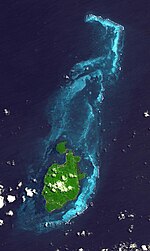User:Steveprutz/jamestown/seaflower

| This user page or section is in a state of significant expansion or restructuring. You are welcome to assist in its construction by editing it as well. If this user page has not been edited in several days, please remove this template. If you are the editor who added this template and you are actively editing, please be sure to replace this template with {{in use}} during the active editing session. Click on the link for template parameters to use.
This page was last edited by Steveprutz (talk | contribs) 4 months ago. (Update timer) |

The Seaflower was a sailing ship built in England. It was most notable for helping settle Puritans on the Caribbean Providence Island colony in c. 1631.[1][2] Regarded as sister ship to the Mayflower, the Seaflower also transported settlers to the New World, specifically to Jamestown, Virginia colony in 1621.[3][4]
In 1629, Privateer Captain Daniel Elfrith (aboard the Robert) scouted the archipelago of "Santa Calatina" for riches and as a staging point for Spanish ship plundering.[5] The Earl of Warwick was looking for a new location to build a colony, yielding the setup of Providence Island Company.[6] In c. February 1631, 100 men and boys (mostly Puritans recruited from Essex, England) boarded the Seaflower, sailing from Deptford to Providence Island.[7] The passengers settled the island, intending to load the ship with exotic plants and produce for profit in London.[8] Seaflower returned to London in March, 1632. It was attacked-at-sea by Spanish during the return voyage, with Captain John Tanner and crew narrowly escaping. The ship's cargo was only a small cargo of poor quality tobacco.[9] Later, the Seaflower returned to Providence Island and was loaded again, this time with 1 tonne (1,000 kg) of "mechoacan potatoes" (Ipomoea purga) for their medicinal value.[10]
In autumn 1676, the ship was still in use, transporting slaves from Africa to the Caribbean.[11] The ship's passengers were taken captive by Metacom, the son of Massasoit.[12]
In 1696, notorious pirates Henry Every and Joseph Faro most likely[note 1] used the ship during their time in and around Rhode Island.[14]
The Seaflower was accidentally destroyed in the Somers Isles (Bermuda) during a English relief mission to Virginia.[15][additional citation(s) needed]
The Marine Protected Area and Biosphere Reserve surrounding the islands is named after the ship.[16][17][additional citation(s) needed]
Notes
[edit]Footnotes
[edit]- ^ It is debatable that the single-sail sloop, the Sea Flower [sic] used by Henry Every was a different ship than the multi-sail Seaflower.[13]
References
[edit]- ^ Coldham, Peter Wilson (1987). The Complete Book of Emigrants: 1607–1660. Genealogical Publishing Com. ISBN 978-0-8063-1192-0. Retrieved 9 September 2012.
- ^ https://www.tomfeiling.com/the-island-that-disappeared-US-edition.html
- ^ Feiling, Tom. The Island that Disappeared: The Lost History of the Mayflower's Sister Ship and Its Rival Puritan Colony. p. 32. ISBN 978-1-61219-708-1.
- ^ Stevens, Anne. "Seaflower 1621". Packrat Productions. Retrieved 23 April 2024.
- ^ Feiling, Tom. The Island that Disappeared: The Lost History of the Mayflower's Sister Ship and Its Rival Puritan Colony. p. 3. ISBN 978-1-61219-708-1.
- ^ Feiling, Tom. The Island that Disappeared: The Lost History of the Mayflower's Sister Ship and Its Rival Puritan Colony. p. 9. ISBN 978-1-61219-708-1.
- ^ Feiling, Tom. The Island that Disappeared: The Lost History of the Mayflower's Sister Ship and Its Rival Puritan Colony. p. 30-33. ISBN 978-1-61219-708-1.
- ^ Feiling, Tom. The Island that Disappeared: The Lost History of the Mayflower's Sister Ship and Its Rival Puritan Colony. p. 39. ISBN 978-1-61219-708-1.
- ^ Feiling, Tom. The Island that Disappeared: The Lost History of the Mayflower's Sister Ship and Its Rival Puritan Colony. p. 43. ISBN 978-1-61219-708-1.
- ^ Feiling, Tom. The Island that Disappeared: The Lost History of the Mayflower's Sister Ship and Its Rival Puritan Colony. p. 48. ISBN 978-1-61219-708-1.
- ^ Newell, 2015, p. 148. https://mayflowermavericks.wordpress.com/2017/03/03/news2/
- ^ https://mayflowermavericks.wordpress.com/2017/03/03/news2/
- ^ Rogoziński 2000, p. 90
- ^ https://www.cbsnews.com/news/coins-new-england-help-solve-mystery-of-murderous-1600s-pirate-henry-every/
- ^ Stanard, Mary Newton (1928). Story of Virginia's First Century. Philadelphia, PA: Lippincott. pp. 179-181.

- ^ https://www.bbc.com/travel/article/20201014-providencia-an-island-with-a-sea-of-seven-colours
- ^ https://www.car-spaw-rac.org/IMG/pdf/Factsheet_Colombie_Seaflower_Marine_Protected_Area.pdf
